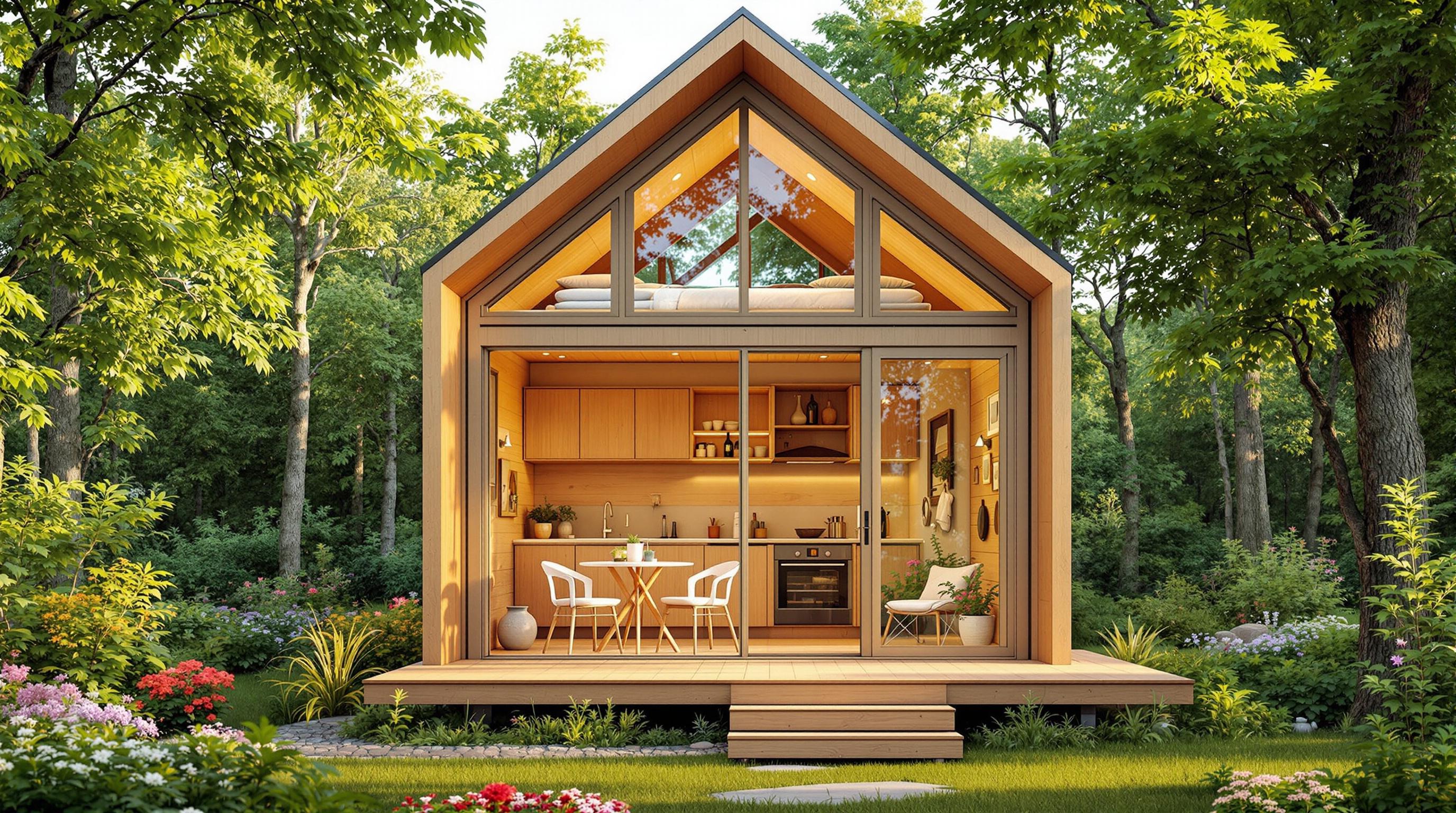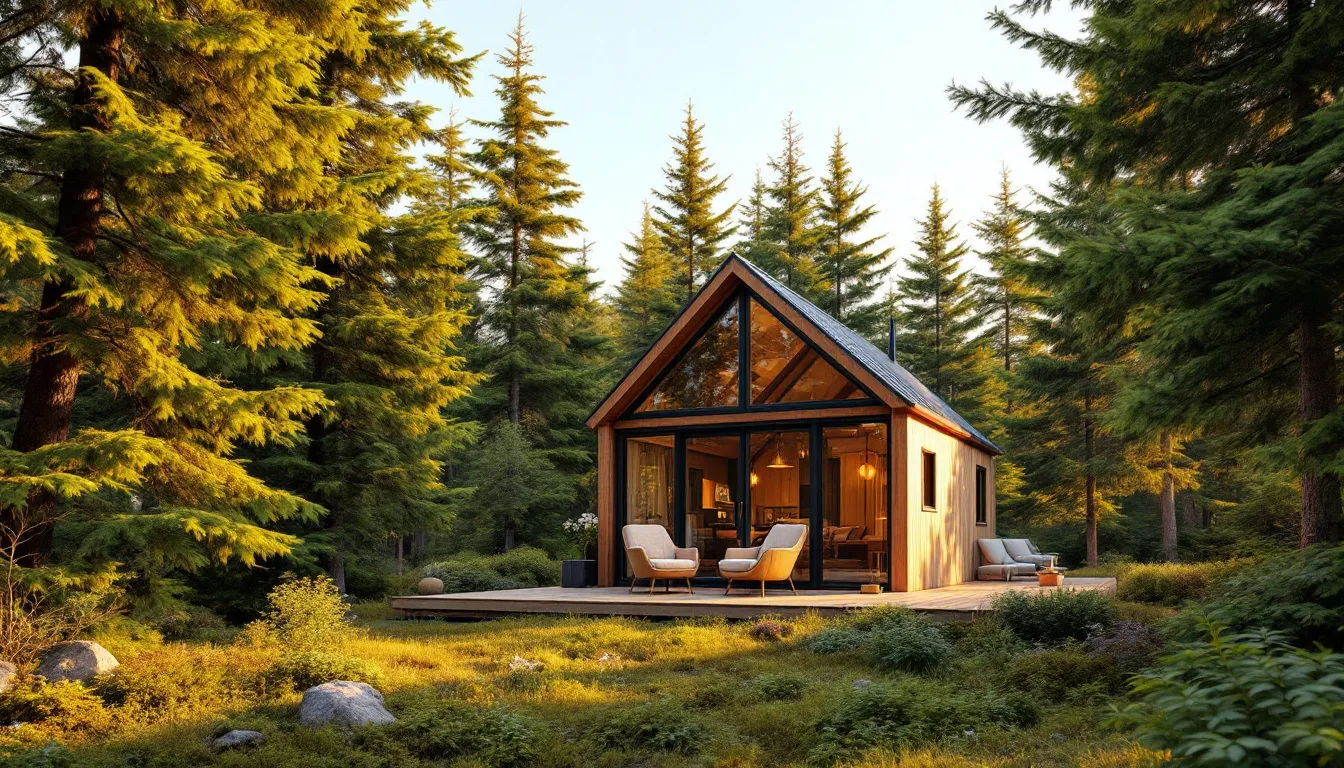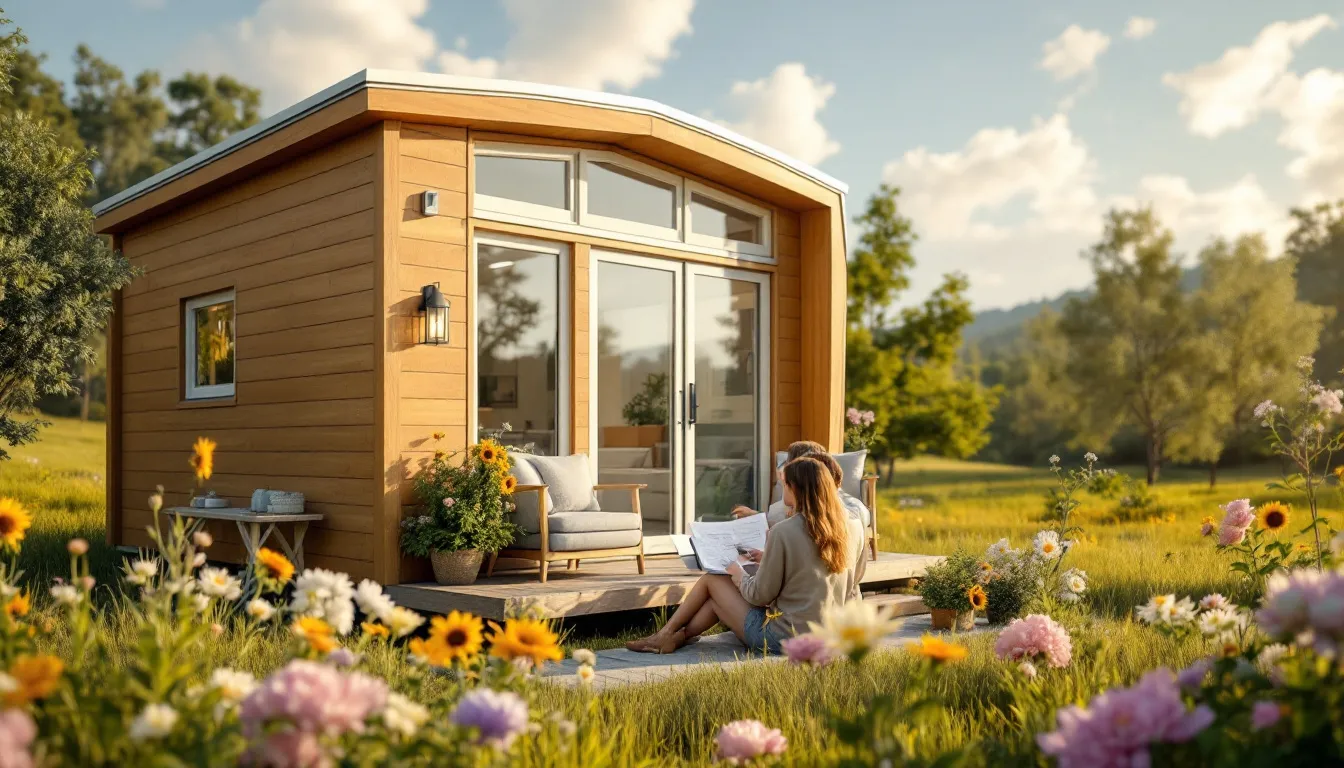Building a tiny house? Here's what you need to know about permits:
- Most tiny houses require building, zoning, electrical, plumbing, and occupancy permits
- Costs typically range from $1,100 to $8,200 total for all permits
- Fixed tiny houses follow standard home rules; mobile ones often fall under RV regulations
- Local laws vary widely - always check your specific area's requirements
- Key building codes: max 400 sq ft, 6'8" min ceiling height, safety features like emergency exits
Quick permit overview:
| Permit Type | Purpose | Typical Cost |
|---|---|---|
| Building | Structure approval | $500 - $5,000 |
| Zoning | Land use compliance | $100 - $1,000 |
| Electrical | Wiring safety | $200 - $900 |
| Plumbing | Water/sewage systems | $200 - $800 |
| Occupancy | Final safety check | $100 - $500 |
Start the permit process early. Work closely with local officials to navigate regulations in your area. With proper planning, you can make your tiny house dream a reality.
Related video from YouTube
Getting Started with Permits
Building a tiny house? You'll need permits. Let's dive into what you need to know.
Required Permit Types
Tiny houses usually need several permits. Here's a quick look:
| Permit Type | What It's For |
|---|---|
| Building Permit | The house structure |
| Zoning Permit | Land use rules |
| Electrical Permit | Wiring and electrics |
| Plumbing Permit | Water and sewage |
| Occupancy Permit | Safety for living |
When You Need a Permit
You'll need permits when:
- Building a tiny house on a foundation
- Turning an existing structure into a tiny house
- Putting a tiny house on wheels as a permanent home
- Making big changes to an existing tiny house
Even houses on wheels need permits. As Zack Giffin from "Tiny House Nation" says:
"There is nobody that is satisfied with the gray area that these homes fit under. Not the clients, not the builders, not the government."
Fixed vs. Mobile Tiny Houses
Fixed and mobile tiny houses have different rules:
Fixed Tiny Houses:
- Treated like regular homes
- Must follow local building codes
- Often called Accessory Dwelling Units (ADUs)
Mobile Tiny Houses:
- Usually seen as RVs
- Need RVIA certification
- Have to follow parking and zoning rules
Permit Costs
Costs vary, but here's a rough idea:
| Permit Type | Typical Cost Range |
|---|---|
| Building Permit | $500 - $5,000 |
| Zoning Permit | $100 - $1,000 |
| Electrical Permit | $200 - $900 |
| Plumbing Permit | $200 - $800 |
| Occupancy Permit | $100 - $500 |
Plan for these costs early. Some places offer discounts for tiny houses or green building, so ask about savings.
Fresno, California is a good example to follow. In 2016, they became the first big California city to allow tiny houses on wheels as permanent homes. They call them "backyard cottages" and say they must be on a lot with a main house.
Start your permit process early. Give yourself a few months to research and do paperwork. More cities are changing their rules for tiny houses, but you need to know what your area requires.
Meeting Building Codes
Building a tiny house isn't just about creating a cozy space. It's also about making sure your home is safe and legal. Let's dive into the key building codes you need to know.
Appendix Q Rules
The 2018 International Residential Code (IRC) introduced Appendix Q, which focuses on tiny house construction. Here's the lowdown:
| Requirement | Details |
|---|---|
| Max Size | 400 sq ft (37 m²), not including lofts |
| Min Ceiling Height | 6'8" (2032 mm) for living spaces |
| Loft Requirements | 35+ sq ft (3.25 m²), 5' (1524 mm) min horizontal dimension |
These rules make it easier to build tiny houses legally while keeping them safe.
Size Requirements
Tiny houses are small, but there are still minimum size rules:
- Habitable Rooms: At least 70 sq ft
- Lofts: Minimum 35 sq ft for sleeping or living spaces
- Bathrooms and Kitchens: 6'4" (1930 mm) minimum ceiling height
But here's the thing: these are general guidelines. Your local building department might have different rules, so always check with them first.
Safety Rules
Safety is a big deal in tiny house construction. You'll need to include:
- Emergency exits in loft sleeping areas
- Stairs and ladders that meet specific dimensions
- Smoke and carbon monoxide detectors in all living spaces
The IRC notes: "Years of experience in tiny house design and construction have shown that, if reasonably designed and constructed, they can provide a safe living environment."
Where You Can Build
Zoning laws are crucial. Here's what you need to know:
Fixed tiny houses are often treated like Accessory Dwelling Units (ADUs). Mobile tiny houses might be classified as RVs, with different rules.
Some cities are becoming more tiny-house friendly. Fresno, California, for example, allows tiny houses on wheels as permanent homes, calling them "backyard cottages."
Here's a pro tip: Always check with your local planning department before you start building. They can give you the inside scoop on local regulations and potential issues.
Building a code-compliant tiny house isn't always easy, but it's crucial. Understanding these requirements upfront can save you from headaches (and big fines) later on.
Extra Rules to Know
Building a tiny house isn't just about basic permits and codes. There's more to it:
Houses on Wheels
Tiny houses on wheels (THOWs) come with their own set of challenges:
Many places see THOWs as RVs. In Colorado, you need to register them with the DMV. But some cities, like Walsenburg, are more open. They let THOWs in all areas if they follow building codes.
Water and Power Setup
Getting utilities for your tiny house? Plan carefully:
| Utility | What You Need to Know |
|---|---|
| Water | Use food-grade hoses or pipes, not garden ones |
| Power | You'll likely need a 50-AMP twist locking receptacle |
| Off-grid | Think about solar panels and batteries |
Always check local rules before hooking up to water and power.
RVIA Certification

For mobile tiny houses, RVIA certification is a big deal:
It makes sure your house is safe. You might need it for insurance and loans. Plus, it lets you park in RV spots.
But here's the catch: RVIA sees your house as a temporary home. That might not work if you want to live there full-time.
Parking Your Tiny House
Where can you park? It depends:
Fixed tiny houses are often treated like Accessory Dwelling Units (ADUs). Mobile ones might face RV-like rules.
Take El Paso County, Colorado. They're cool with tiny houses as ADUs, as long as they're the right size and in the right spot.
"Most of the time, code enforcement only acts if someone complains. If no one sees your house or makes a fuss, you could live there for ages without issues."
Sounds good, right? But it's smarter to follow the rules. It'll save you headaches later on.
sbb-itb-2ef3f3a
How to Apply
Getting permits for your tiny house isn't a walk in the park, but it's a must-do. Here's how to tackle the process:
Papers You Need
Before you jump in, get these documents ready:
| Document | Why You Need It |
|---|---|
| Property deed or lease agreement | Shows you can build there |
| Site plan | Maps out your tiny house location |
| Floor plans | Lays out your tiny house design |
| Structural drawings | Explains the building process |
| Electrical and plumbing plans | Shows how utilities will work |
House Plans
Your tiny house plans are a big deal. They need to show:
- Exact measurements
- How rooms are laid out
- Where windows and doors go
- How electrical and plumbing systems work
Pro tip: Get an architect who knows tiny houses. They'll make sure your plans follow local rules, especially Appendix Q of the International Residential Code (IRC).
Building Checks
Get ready for inspections as you build:
1. Foundation check (for fixed tiny houses)
They'll make sure your house has a solid base.
2. Framing check
This ensures your house's structure is sound.
3. Electrical and plumbing rough-in checks
They'll look at your wiring and pipes before walls go up.
4. Final check
The last hurdle before you can move in.
Each check makes sure your tiny house is safe. Be ready to make changes if the inspector spots issues.
Common Mistakes
Don't fall into these traps when applying for permits:
- Forgetting about zoning laws. Check if tiny houses are OK in your area first.
- Turning in incomplete applications. Missing papers can slow things down.
- Not planning utility hookups. Make sure you've got water and power figured out.
- Overlooking parking. For mobile tiny houses, show where you'll park long-term.
Keep in mind, the process can be different depending on where you are. In San Jose, California, for example, getting permits for tiny houses can be tough due to strict local rules.
"Work closely with your local building department from the start", says Andrew Morrison, a tiny house builder and teacher. "They can guide you through what your area requires."
Rules by Location
Tiny house rules change a lot depending on where you are. Let's look at how they differ across places.
State Rules
States handle tiny houses differently:
| State | Tiny House Rules |
|---|---|
| California | Super tiny house-friendly |
| Maine | Calls homes under 400 sq ft tiny houses |
| Texas | Cities like Austin and Spur love tiny houses |
| Washington | Easier on tiny homes built on foundations |
California's really into tiny houses. In 2020, they told cities and counties to make plans for Accessory Dwelling Units (ADUs). This led to cool stuff like Clovis giving out free tiny house plans to some property owners.
City vs. Country Rules
Cities and rural areas often have different rules:
Cities usually have tougher zoning laws and building codes. Rural areas? They're often more chill about it.
Take Spur, Texas. They got rid of minimum size rules for tiny homes. It's now a tiny house paradise.
But cities like San Jose, California? Tough permit process. Still, some cities are changing. Fresno, California was the first U.S. city to say tiny houses on wheels could be secondary living units.
Other Ways to Meet Rules
If local rules are hard, try these:
1. RV Parks
Some places let you park tiny houses on wheels in RV parks.
In Pima County, Arizona, tiny homes with foundations are treated just like regular houses.
3. ADU Classification
Lots of places now let you have tiny houses as Accessory Dwelling Units.
Santa Cruz County in California made it legal to have tiny homes on wheels as single-family homes. Now you can put a tiny house on your property without the hassle of building a regular house.
Working with Officials
Dealing with local rules is key. Here's how:
- Do your homework on local rules before you start
- Talk to local building departments early on
- Have your plans and paperwork ready
Andrew Morrison, who builds and teaches about tiny houses, says:
"Work closely with your local building department from the start. They can guide you through what your area requires."
Getting Help
Building a tiny house isn't always a walk in the park. Sometimes, you need to call in the pros. Here's when and how to get expert help.
Do You Need an Expert?
You might want to bring in a pro if:
- You're scratching your head over local rules
- Zoning laws in your area are giving you a headache
- Your tiny house design is a bit... out there
- You've got a violation notice sitting on your desk
A local real estate guru can clue you in on:
| What They Know | Why It Matters |
|---|---|
| What tenants want | So you can build a tiny house people actually want to live in |
| How much you could charge | To see if your tiny house investment makes sense |
| What's hot in your area | To gauge if there's a market for your tiny home |
Finding Good Builders
Picking the right builder is key. Here's how to spot a good one:
Look for someone who's built tiny houses before. Ask to see their work and chat with past clients. Make sure they know the local building codes like the back of their hand. And don't forget to check if they're licensed and insured.
"A good builder is worth their weight in gold. They can save you from costly mistakes and headaches down the road." - Tiny House Expert
Legal Help
Sometimes, you need a lawyer in your corner. Think about getting legal help if:
- The city's giving you grief about your tiny house
- You need to ask for special permissions
- You're not sure if your tiny house plans are even legal
A land use lawyer can help you understand your rights, navigate the red tape, and go to bat for you if things get sticky.
Tiny Houses For Sale, Rent, and More

Check out Tiny Houses For Sale, Rent, and More. It's a one-stop shop for tiny house fans. You can find builders, learn about tiny house living, and get the scoop on local laws.
Remember, working with your local officials is crucial. As Andrew Morrison, a tiny house pro, puts it:
"Work closely with your local building department from the start. They can guide you through what your area requires."
Getting expert help might cost a bit upfront, but it can save you a ton of headaches (and cash) in the long run.
Wrap-Up
Navigating tiny house permits can be tricky. Let's recap the key points:
Local Rules Vary
Tiny house laws change from place to place. Fresno, California lets you park tiny houses on wheels in backyards. Other areas? Not so much.
Building Codes Matter
Most places use the International Residential Code (IRC) as a starting point. It says livable rooms should be at least 70 square feet with 7-foot ceilings.
Zoning is Key
Zoning laws decide where you can put your tiny house. Some areas are cool with it, others aren't. Rockledge, Florida has special zones for tiny houses on wheels and foundations.
You Need Permits
Fixed or mobile, you'll need permits. Here's a quick look at common types:
| Permit Type | What It's For | Usual Cost |
|---|---|---|
| Building | House structure | $500 - $5,000 |
| Zoning | Land use rules | $100 - $1,000 |
| Electrical | Wiring | $200 - $900 |
| Plumbing | Water and sewage | $200 - $800 |
| Occupancy | Safety check | $100 - $500 |
Size Counts
Most places call houses under 500 square feet "tiny." Maine says it's under 400 square feet.
Fixed vs. Mobile
Tiny houses on wheels? Often treated like RVs. Fixed tiny houses? Maybe seen as Accessory Dwelling Units (ADUs).
Utility Hookups
Plan how you'll get water and power. Some places have rules about off-grid setups.
Get Help
Don't be afraid to ask local officials, experienced builders, or lawyers for help.
Many areas are warming up to tiny houses. As Andrew Morrison, a tiny house pro, says:
"Work closely with your local building department from the start. They can guide you through what your area requires."
The process might seem tough, but with the right info and help, you can make your tiny house dream a reality.
FAQs
Is a tiny house considered a permanent residence?
It's not a simple yes or no answer. Several factors come into play:
- Where you want to live
- The type of tiny house you have
- Local laws and building codes
Let's break it down:
In some places, tiny houses are welcome. In others? Not so much. Take California, for example:
- Fresno says "sure" to tiny houses on wheels as extra living spaces
- San Francisco? They're not fans of rooms under 70 square feet
- Sacramento? Right now, they're not on board with tiny houses as permanent homes
Andrew Morrison, who knows his stuff about tiny houses, says:
"Work closely with your local building department from the start. They can guide you through what your area requires for a tiny house to be considered a permanent residence."
Here's what you need to think about:
Tiny houses are usually between 80-400 square feet. That's small!
Houses on foundations have a better shot at being called "permanent" than those on wheels.
You'll need the right permits if you want your tiny house to be a permanent home.
Permanent hookups for water and power? Often a must-have.
And don't forget to check if your area even allows tiny houses in residential zones.
The bottom line? It's all about where you are and what the local rules say. Do your homework before you commit to tiny living!



